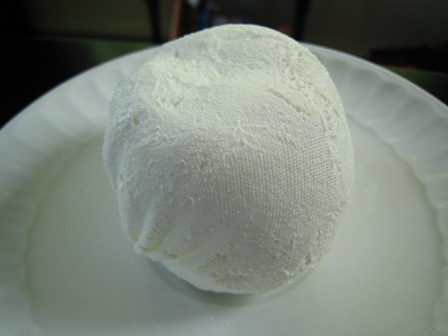CURDS OUR WHEY – CHEVRE

I’m a few days late, but it’s time for the June Curds Our Whey. This month I chose for us to make Chevre cheese. Chevre is the French word for “goat”.
I was really looking forward to making the Chevre until I began my search at the grocery stores. When making cheese, you want to use pasturized, but not ultra-pasturized. The curds don’t usually form properly when using ultra-pasturized. I checked every grocery store and health food store I could think of in Anchorage, and the only goat’s milk I could find was ultra-pasturized. The recipe also called for a gallon of goat’s milk, and the only size available to me was quarts. At around $6/quart, and when I didn’t think it would turn out, I wasn’t willing to try with more than one quart. So I divided my package of starter into quarters, and proceeded to make the cheese.
This recipe is very easy. Heat the milk, add the starter, and let it sit at room temperature for 12 hours. I needed to go to bed, so mine only set for about 10 hours. But it did already have the “yogurt texture” called for. Well, a little softer than yogurt, but I didn’t have a choice. So before going to bed, I drained it. I let it drain overnight, and it was still too soft. This was Friday morning, and I was leaving town for the weekend, so I decided to tie the muslin to a long spoon, hang the cheese over a bowl, and refrigerate until I came home on Sunday. When I checked it on Sunday, it was perfect. A little softer than the kind I buy in the grocery store, but still firm enough that I could cut into rounds to place on a salad.
Another thing that suprised me about the cheese was the yield. I thought by using only a quart that my yield would be next to nothing. I forgot to weigh the cheese before I used it, but it was a little more than a small ball or log that you would buy at the store. So maybe between 6 and 8 ounces? If I used an entire gallon of milk, I’m not sure what I would do with that much goat cheese.
I’ll post in the next couple of days how I used the Chevre. One thing the cookbook suggests is to use it as a spread, flavored with herbs and spices. Or it also can be used as a substitute for cream cheese.
Here’s the ball of Chevre that was my end result.
Chevre
1 gallon pasturized whole goat’s milk
1 packet direct-set chevre starter
1. Heat the milk to 86 degrees F. Add the starter, stirring to combine.
2. Cover and let set at a room temperature not below 72 degrees F. for 12 hours. (Works well to make it at night, then drain it in the morning.)
3. Line a colander with butter muslin. Gently ladle the curds into the colander. Tie the corners of the muslin into a knot and hang the bag over the sink to drain for 6-12 hours, or until the curds reach the desired consistency. (A shorter draining time produces a cheese spread; a longer draining time produces a cream-cheese-type consistency.) A room temperature of at least 72 degrees will encourage proper draining.
4. Store in a covered container in the refrigerator for up to 1 week.
Yield: 1 1/2 pounds


Your chevre looks really good. I am having cheesemaker’s block right now, so no goat cheese yet!
Cindy, it looks great! I am glad it worked out with ultra-pasteurized milk.